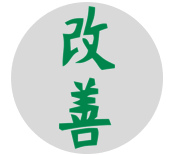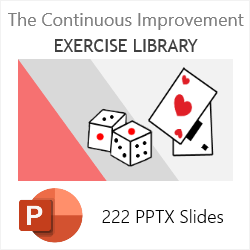
Also known as Kaizen Program, Good Change and Continuous Improvement.
Kaizen is a Japanese idea that means making small, steady improvements every day. Instead of waiting for big changes, Kaizen focuses on fixing little things that add up to big results over time. This Lean method works step by step and can be applied to any process in business, school, or even daily life. At its heart, Kaizen is about creating a culture where improvement never stops. The main goal is to keep raising standards in a simple and practical way.
Kaizen began in Japan after World War II, when Japanese companies learned new ideas from American experts about quality and efficiency. Toyota played a huge role in shaping Kaizen by involving employees in solving problems and improving work daily. What started as a shop floor practice in factories soon spread to other industries like healthcare, education and services. By the 1980s and 1990s, Western companies also adopted it as part of Lean manufacturing. Today, Kaizen is used worldwide as a trusted way to improve processes and performance.
The word “Kaizen” comes from two Japanese words: “Kai” meaning change, and “Zen” meaning good or better. Together, Kaizen means “change for the better” or continuous improvement. Kaizen is not only about work but also about creating a disciplined, positive mindset of always looking for ways to get better. It’s about improvement every day, everywhere, and by everyone.

Kaizen Principles
Kaizen is built on simple but powerful principles and has a set of guiding concepts that support its success. First, Kaizen is a mindset of accepting that change is constant and improvement never stops. It focuses on making many small improvements instead of huge radical changes. Improvements should happen daily and involve every department in the company. The customer is at the center of all Kaizen efforts, and every change should make things better for them. Moreover, decisions are based on data and measurable results, not just guesses.
As an example of Kaizen in action, closing the small gaps under entrance doors can prevent dirt and dust from entering the building, reducing the need for frequent cleaning. This simple improvement saves time and effort while keeping the workplace cleaner. Another example is installing small mirrors at busy corners inside a factory so workers and forklift drivers can see around them more easily, improving safety. These small, practical changes demonstrate how Kaizen focuses on making daily work safer, smoother, and more efficient.
Kaizen is very flexible and can be applied in many ways. Companies use Kaizen to eliminate waste, standardize processes, improve safety, improve quality of products and services, improve customer satisfaction, job satisfaction, and teamwork. It is also useful for speeding up delivery times and solving problems faster. Any small change that leads to lasting improvement in performance, efficiency, or quality is considered Kaizen.

Everyone is a Change-Maker
People are at the heart of Kaizen. Successful Kaizen is not only about fixing processes but also about valuing and nurturing people. Employees at all levels are encouraged to share ideas and take part in continuous improvement. Kaizen provides employees with opportunities to develop new problem-solving skills they can apply repeatedly. When people feel trusted and involved, they bring new energy and creativity that push the company forward.
Kaizen empowers workers by letting them find problems, suggest solutions, and make improvements themselves. When teams meet aggressive goals, they feel proud and accomplished. Other employees often want to join in once they see the results. This builds confidence and spreads a culture of teamwork and ownership.
For Kaizen to work, leaders must believe in it and show commitment. They should encourage teams, remove barriers, and provide the right environment for change. Everyone, from the CEO to frontline staff, can play a role. Leaders who actively participate set the example and inspire others to join in. They ensure that Kaizen is not just a short-term idea but a long-term culture.

Kaizen in Action
Kaizen often follows a structured approach to improvement, including the PDCA cycle or the DMAIC framework. It can also be focused on a Gemba-based approach where the team spends significant time at the actual workplace observing processes directly and finding solutions. To do this effectively, team members typically require training to understand the eight wastes, value streams, and other key Lean concepts.
On the other hand, a Kaizen event is a focused workshop where a team works intensively on solving a specific problem. These events usually last few days and aim to show results quickly. Unlike long projects, Kaizen events are fast, practical, and highly engaging. They bring together cross-functional teams and experts to make real changes. Teams observe the process, find waste, and come up with solutions that can be implemented immediately.

Employee suggestion boxes and idea logs provide simple and accessible ways for employees to capture improvement ideas and report problems in their daily work. Together, they are fundamental tools for sustaining and expanding the Kaizen culture.
Wrapping Up
Improvement doesn’t have to be big or complicated, it can start with small, simple steps. Many changes are easy low-hanging fruit that can be achieved through Kaizen efforts and quick wins. It’s about using common sense and teamwork rather than costly solutions.
More than just a method, Kaizen is a mindset where improvement is always possible. When people and leaders embrace Kaizen, they create workplaces that are efficient, creative, and human-centered. Ultimately, Kaizen teaches us that lasting success is achieved step by step, through continuous daily effort.
References
Rob, M. Crown Holdings. Process Improvement Program.
Imai, M. Kaizen: The Key to Japan’s Competitive Success. McGraw-Hill.
Kubiak, T. M. The Certified Six Sigma Master Black Belt. Infotech.


